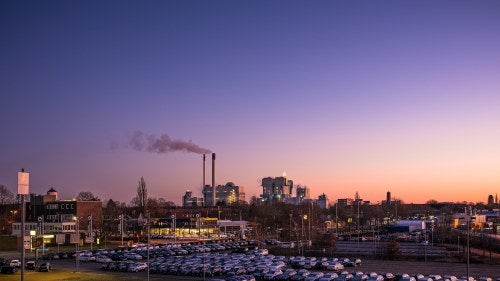Germany Accelerates Change in Its "Rust Belt"

Both the United States and Germany are seeing evolving economies in their respective "rust belts," formerly robust engines of the industrial era.
Both the United States and Germany are seeing evolving economies in their respective “rust belts,” formerly robust engines of the industrial era. Both countries are developing strategies to address the challenges the regions are facing. But while President Trump’s approach tries to bring back the past, Germany is focused on accelerating change so the region will thrive in the future.
“Here we are proud of our industrial history; we are the hard workers that drove our nation’s economy forward after World War II.”
I could have been in Flint or Detroit, Michigan. Instead, I was hearing from the local manager of a new startup and innovation hub deep in the “Ruhrgebiet” – Germany’s coal and steel region, once home to heavy industry and twin to our nation’s “rust belt.”
As part of a Public Diplomacy Visitors program sponsored by the German government, I joined an international delegation to examine Germany’s approach to structural change. I was struck by two realities: How similar are the economies and cultures of our industrial regions; and how divergent are the countries’ approaches to dealing with similar dynamics of economic dislocation and change.
In parts of former East Germany, and the Ruhr industrial belt in the West—just like here at home in America’s industrial Midwest—there is great cultural pride in being the economic engines of our countries; places where a middle-class life was afforded through manual labor and hard work. These regions are home to communities where workers were treated as heroes, and labor unions were strong.
Today many parallels remain. There certainly is nostalgia in both our Midwest and many German communities for the days of humming mills, mines, factories and bustling communities. They are both ground zero for the current political debate about the role of migrants and immigrants: On the one hand welcoming immigrants for much needed new talent, population, enterprise and community revitalization; on the other hand, places where many residents are responsive to fear-mongering about a more diverse and changing polity and culture.
But the approaches to deal with today’s transformations are dramatically different. While in the United States there is increasing talk and concern about ameliorating our growing regional economic disparities, the Germans are running plans to do something about it, aided by a more politically durable and aggressive commitment to “balance” growth—emanating from their Constitution.
The German Constitution explicitly sets a goal of affording equal living conditions and quality of life for residents—wherever they are. This has set up a durable, above-politics, non-partisan consensus that government should purposefully do what it can to aid adjustment in disadvantaged regions—those undergoing economic disruption and change. Hence German politicians and their constituents in the rural and formerly industrial regions remain supportive of federal and even EU-wide economic adjustment policies and programs.
While not in the US Constitution, our Declaration of Independence promises life, liberty and the pursuit of happiness for all citizens—but the United States has no such shared consensus to aid residents of region’s struggling with economic change. If anything, the “anti-government” bias of the Tea Party and conservatives has fanned anger over government programs ranging from healthcare extension and social welfare supports, to clean energy and economic development programs—in regions that arguably, have the greatest need for extra government stimulus.
The German government strategy is more about embracing change, and putting it to work to accelerate economic adaptation, a stark contrast to President Trump’s strategy of peddling nostalgia for the “good old days,” trying to bring back jobs that will not be a part of the future economy.
Recognizing the need for climate action, former mining and steel communities, like Bottrap, are organizing around a goal of reducing carbon emissions 50 percent in 10 years. As a prototype for other Innovation Cities, they are testing a model of how to support new sustainable business growth, technology deployment, and build a community with rich quality of life and place. We also witnessed the last coal mine of the Ruhrgebiet cease active operations; ending a 25-year planned phase out of coal and steel mines that once defined this region. Germany supported the effort with generous financial transition aid and with retraining and relocation assistance for displaced workers to find niches in new, growing industries and communities.
is also repurposing old infrastructure. The Zollverein Coal Mine Industrial Complex in Essen, one of the iconic coal and steel facilities that more than a century ago revolutionized these industries, is today a UNESCO World Heritage site, museum, conference area, and start-up incubator. It serves technology firms playing to the region’s strengths and numerous small- and medium-sized enterprises to provide new data and business-to-business solutions.
There is remarkable support for research and development and innovation. The Fraunhofer Institute in Duisdorf, for example, is one of a network of seventy-two public and privately funded applied research institutions sprinkled across Germany that aid Germany’s dense network of SMEs to develop new cutting-edge processes and products. Several new institutes were newly created in former industrial regions beginning twenty-five years ago as part of a deliberate effort to create new centers of talent, research and development, and innovation support as nuclei for the economic transformation of their "rust belt" communities.
The German federal government is extending digital backbones and high-speed internet access to small towns and rural regions so firms, entrepreneurs, families, schools, and research institutions can be full participants in today’s economy. They are also looking past 4G toward revolutionary 5G which will reinvent communications products and processes.
They are accelerating the digital revolution, “Industry 4.0,” moving past automating occupations to building machine learning systems to manage data exchange, networks, inventories, and communications in the Internet of things, and up and down the supply and production chains.
And finally, Germany is working to update the social insurance system and their celebrated occupational training programs to better support adaptation for a fast-changing workplace, including lifelong retraining and re-credentialing.
The Germans are certainly planners, and some of these efforts do have a top-down, heavy-handed quality—despite good rhetoric about community participation and inclusion. And I would not trade nor want to kill off the chaotic, entrepreneurial, and hypercompetitive character of our US and Midwest innovation landscape, where no one plans the next disruptive technology, but rather it is sparked and grows spontaneously from our network of public-private research, market-driven technology development end (often immigrant) entrepreneurs. However, a country that commits to do what it can to balance growth and ameliorate yawning geographic and personal opportunity divides can nurture a more equitable economy, as well as a less polarized polity.
In America’s proud industrial heartland, we need leadership willing to name and make real progress on some of the fundamental infrastructures that do underpin economic adaptation and growth: enhancing connectivity, building out from our own leading research and learning institutions, helping workers adapt to change, leveraging our storied history and culture, and embracing the sustainability revolution for economic benefit. More success in these efforts will smooth both our economic differences and the estrangement people in many communities feel from the broader society.

